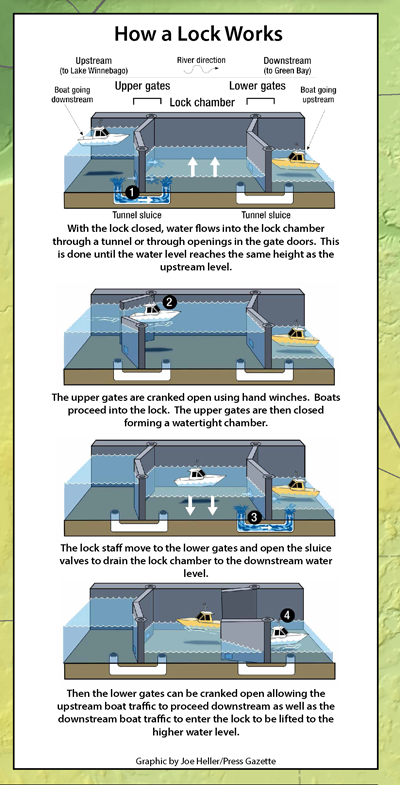The Authority is funded by a combination of match funds from federal, state, and local fundraising dollars. When the authority was established, an agreement was reached in which the federal government gave funds that were earmarked to close the locks to the FRNSA on the condition the local citizens could raise additional funds. The state matched the locally donated funds.To operate the locks, the authority uses the interest on investments, lock user fees, rental income and state funding.
In accordance with state statutes, the Authority will continue to maintain a sea lamprey barrier at the Rapide Croche lock. The lock is a barrier to prevent invasive species from the Great Lakes invading the Fox River and Lake Winnebago ecosystems. Board members of the FRNSA value sport fishing on the waterway and maintain an aquatic invasive species management plan.
The 17 locks of the Lower Fox River have many similar features, and work on the same principle. The most surprising feature to most visitors is that each of the actions described in the graphic (right) are performed by manual labor. No electric motors, no pumps, no automatic valves. Nearly 500,000 gallons of water moved in/out during each “lockage” thanks to some clever engineering that took place over 150 years ago. And due to the effort of the lock tenders.
Proper operation of the lock relies on the the large upper and lower gates sealing correctly when closed which holds back many tons of water. Look closely at how each pair of gates comes together, or “miters” right in the middle. This important design feature forces the two gates to seal tightly as the water level difference increases from one side of the door compared to the other.
The bad news is the lock tenders won’t even try to open the big gates and let the boats out until the water level on opposing sides has evened out. Even with a single inch of water level differential, the gates can’t be muscled open. So it can be a bit of a waiting game. Lock tenders often joke with the boaters that traveling through the locks is not the route to take if you’re in a hurry but it is the route to take if you want a one-of-a-kind experience with living history.

There are 17 locks on the Fox River.
The Fox River is one of the rivers in the United States that runs from South to North from Lake Winnebago to the bay of Green Bay
The Menasha lock (the southern-most lock) is referred to as the “upriver” lock.
Locks closer to Green Bay are referred to as “downriver” locks.
The locks were constructed in the 1850s. Most of them required various types of re-building phases in the decades that followed. We generally like to say that the system was created around the time that Wisconsin became a state.
The original owners included, private investors, quasi-government agencies, State of Wisconsin and Federal Military. Presently, the system is owned and operated by the State of Wisconsin.
Individual locks on the system are listed on the National Register of Historic Places.
From South to North the locks are:
The system of locks covers 39 miles, Lake Winnebago to Green Bay, and drops in elevation 168 feet—a vertical drop equal in height to the total drop of Niagara Falls.
Kaukauna features the steepest drop in elevation: a drop of 50.4 feet in just over one mile
The system operates from May to early September.
It takes about 600,000 gallons of water to cycle a lock. All of this water stays in the Fox River.
By the end of 2020, more than 17,700 people went through the locks on almost 4,000 boats.
The locks are one of the few hand-operated, functional lock systems in the nation. Lock tenders manually operate the valves that control water entering and leaving to change the water level and manually crank open the lock gates.
The locks are not open in the winter. Due to river ice, the locks’ season is generally from May until October.
No. The lock tenders are employees of the Fox River Navigational System Authority.
Yes it is. There was a period of time in the early 1980s that some of the locks were operated by convicts from Sanger Powers Correctional Center in Oneida.
Only one set of lock gates can be opened at a time because of the pressure created by the water level differential. Even an inch of water level difference will prevent the doors from opening. An additional reason why this wouldn’t be a good idea is that a “flow-thru” lock would drain down the water level in the pool above the nearby dam.